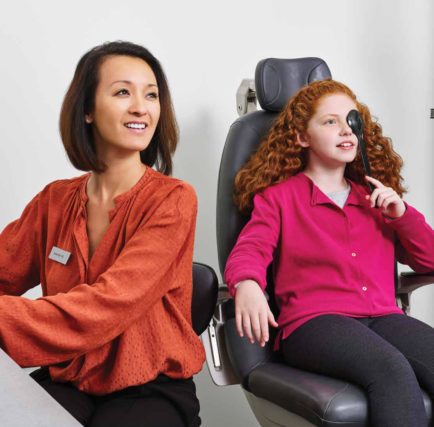Myopia Management Resource
Myopia is commonly diagnosed in childhood and can worsen over time, increasing the risk of more severe sight conditions later in life. We're here to help.

The Increasing Prevalence And Severity Of Myopia In Children
More than 40 percent of Americans have myopia and that number is increasing at an alarming rate, especially among school-age children. One in four parents have a child with myopia and about three-quarters of children with myopia were diagnosed between the ages of 3 and 12.2 Two-thirds of Eye Care Practitioners (ECPs) say the presence of myopia among children in their practice has increased over the past 5-10 years, and 81% of ECPs recognize it as one of the biggest problems impacting children’s eyesight today.
Cause of Myopia
Myopia typically occurs during childhood when the eyeball develops a longer shape, meaning the distance between the front of the eye and the retina at the back of the eye is longer than an eye without myopia.
Blurry vision due to myopia is the result of light rays focusing at a point in front of the retina rather than directly on its surface. However, the upward incidence of myopia can be attributed to different factors, and is occasionally the result of a combination of these factors:
- Genetics – Family history plays a role in a child’s risk of myopia. If neither parent has myopia, the chance the child will develop myopia is relatively low. But if one parent has myopia, it increases the child’s chance of developing myopia by 3x – doubling to 6x if both parents have myopia.
- Environment – Exposure to sunlight, vitamin D levels, dopamine levels and the amount of time a child spends outdoors may have an impact on the likelihood of myopia development. Research shows spending more time outdoors lowers the risk of developing childhood myopia.


Managing Myopia
Trouble seeing the board at school, frequent squinting, complaints of headaches, a rising amount screen time—whatever prompted you to schedule an eye appointment for your child, it was clear: something was wrong. Next, you learn that your child has myopia or nearsightedness.
The earlier myopia management starts, the better the outcomes for the child’s nearand long-term eye health. In the U.S., 71% of ECPs say it is absolutely essential to slow the progression of myopia among children ages 8 – 15 years old.
Managing myopia progression by even 1 diopter
- Reduces risk of myopic maculopathy by 40%
- Reduces risk of open-angle glaucoma by 20%
- Reduces risk of visual impairment by 20%
- Saves between 0.5 and 0.9 years of visual impairment
Not only does slowing the progression of myopia help preserve your child’s vision, it keeps their eyes healthier and at less risk for serious eye conditions later on such as cataracts, glaucoma and retinal detachment, all conditions that can lead to visual impairment and even blindness. Fortunately, you have options to support your child’s eye health and keep their future bright.
In our practice, we can walk you through myopia management options, including CooperVision’s Brilliant Futures™ Myopia Management Program with MiSight® 1 day contact lenses. Together, we can explore what will be the best fit for your child, their preferences and their lifestyle. We’re very excited that we’re certified to offer MiSight® 1 day, the first and only daily soft contact lens FDA approved* to slow the progression of myopia in children, aged 8-12 at the initiation of treatment. It’s a simple and safe solution that works for many lifestyles, as well as being proven to slow myopia progression by about 59% on average. To top it off, research also tells us that compared to children in glasses, children in contact lenses report better quality of life, especially for recreational activities and their self-perceived appearance.
